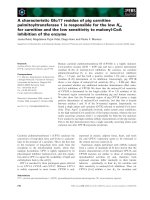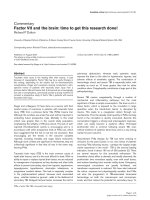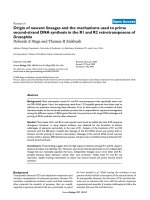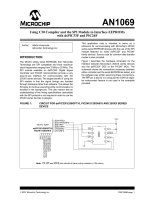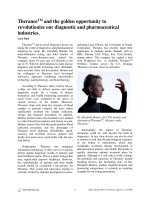Cognitive dysfunction and the inherited predisposition to alcoholism
Bạn đang xem bản rút gọn của tài liệu. Xem và tải ngay bản đầy đủ của tài liệu tại đây (815.96 KB, 7 trang )
Journal of Studieson Alcohol, Vol. 53, No. 2, 1992
Cognitive Dysfunctionand the Inherited Predisposition
to Alcoholism*
JORDANB. PETERSON,
PH.D.,PETERR. FINN, PH.D.,
•' ANDROBERTO. PIHL, PH.D.
Departmentof Psychology,
McGill University,1205DocteurPenfieldAvenue,Montreal,QuebecH3A lB1, Canada
ABSTRACT. A batteryof neuropsychological
testswasadministered
to 22 nonalcoholic sons of male alcoholics (SOMAs) from families
with extensive histories of male alcoholism and to 22 nonalcoholic
controlswith no historyof familialalcoholism.In eachgroup11 subjects were tested while soberand 11 were testedwhile alcoholintoxicated.Analysesof the resultsof this batterysuggested
(1) that
SOMAs may be characterized
by comparative
decrements
in those
cognitivefunctionsassociated
with the organization
of novelinformation,dependent
in theoryuponthe prefrontalcortex;and (2) that
alcoholdetrimentallyaffectsdelayedmemory,associated
with the
temporalcortex, equallyacrossgroups.Of theseSOMAs 20 had previously participatedin one of two studiesthat demonstratedtheir
cardiovascularhyper-reactivity to threat/stressand their increased
sensitivityto the reactivity-dampening
effectsof alcoholintoxication.
Correlationalanalysesof the resultsof the presentand previousstudies demonstrated
the existenceof a highly significantrelationship
between cognitive impairment, cardiovascularhyper-reactivityand
susceptibilityto the reactivity-dampening
effectsof alcohol.(J. Stud.
Alcohol 53: 154-160, 1992)
Granit (1977) reviewedgeneralneuropsychological
infor-
A VARIETY
of
studies
have
demonstrated
that
the mation suggesting(1) that the prefrontalcortex provides
sonsof male
alcoholics
(SOMAs)
are at heightened
geneticrisk for the development
of alcoholism.None of
thesestudiesare abovereproachmethodologicatly
(Lester,
1988;Murray et at., 1983;Searles, 1988), but takencollectivelythey suggest
that SOMAs are threeto ninetimes
morelikely to becomealcoholicthanare the sonsof nonalcoholics(Cloningeret al., 1988; Goodwin, 1985). The
precisenatureof this increased
risk remainsunknown,but
in recentyearsa numberof markersthat appearin association with it have been tentatively identified (Begleiter
and Porjesz, 1988). These markershave been described
critically,in detail, by Pihl et al. (1990).
A number of studies have demonstrated that SOMAs
performmorepoorly than controlson testsof linguistic
ability, abstractionand problem solving(Drejer et al.,
1985;Gabrielli and Mednick, 1983;Whipple et at., 1988).
Additionalevidenceexistssuggesting
that SOMAs hyperreact psychophysiologically
to threat and novelty (Finn
and Pihl, 1987, 1988; Finn et al., 1990). Tarter et al.
(1985, 1988) have drawn a parallel betweenthe cognitive
and behavioralstylesof SOMAs and of thosewith minor
prefrontal
corticaltrauma.Gray(1982, 1987),Luria(1980),
Vinogradova(1975), Nauta (1974), Sokolov(1969) and
Received:September20, 1989. Revision:February27, 1990.
*This research
wassupported
in partby the MedicalResearch
Council
of Canada.
*PeterR. Finnis withtheDepartment
of Psychology,
IndianaUniversity, Bloomington,Ind.
154
the physiologicalsubstratefor the cognitivefunctionsassociatedwith abstractclassificationand planning;(2) that
the prefrontal cortex serves to inhibit or modulate the
functionof varioussubcorticalstructures,includingthose
governingthreat or novelty response;(3) that the hippocampus and hypothalamusare critically involved in this
threatresponse;and (4) that alcoholintoxicationmight interfere with hippocampalfunction.
Petersonand Pihl (1990), integratingthese sourcesof
information, have hypothesizedthat SOMAs have difficulty in abstractlyclassifyingand/orin modulatingtheir
reactionto threateningor novel information,perhapsbecause of mild decrementsin prefrontalfunction. They
suggestalcohol consumptionmight amelioratethe negative subjectiveconsequences
of this difficulty--associated
with increasedphysiological
reactivity--by interferingwith
the function of the novelty/threat response system.
Three primary hypotheseswere derived from this theory, for the purposesof the presentstudy.It was predicted
that (1) soberSOMAs would perform more poorly than
controlson cognitivetestsof classificationand planning,
generally associatedwith prefrontalfunction; (2) alcohol
intoxicationwould interferewith the performanceof both
groupson those neuropsychological
tests that putatively
assesstransferof informationinto long-termmemory,associatedwith the hippocampus;
(3) decrements
in prefrontal functionamongSOMAs would be correlatedwith their
cardiovascular
hyper-reactivityto threat.Thesehypotheses
PETERSON
were to be tested in three parts. The first part involved
assessment
of the neuropsychological
function of stringently selectedsober SOMAs and controls, in order to
help determineif and in what mannertheir cognitiveabilities differed. The secondpart involved a similar assessment, conductedupon intoxicatedSOMAs and controls,
in order to help determine primarily what neuropsychological functionsalcoholintoxicationimpairsper se and,
further, to investigatewhether SOMAs and controlsdiffer in their susceptibilityto alcohol'seffect on cognition.
The third part of the study involvedinvestigationof the
relationshipbetween the cognitive functioningof these
SOMAs and their previously reported (Finn and Pihl,
1987, 1988) cardiovascularreactivity, and sensitivity to
dampening(Finn and Pihl, 1987, 1988) of that reactivity
by alcoholconsumption.
ET AL.
155
In the secondgroup were 22 men recruitedby newspaper advertisementas paid controls.Healthy nonalcoholic
moderate social drinkers (between 5 and 15 drinks/week)
with between 13 and 14 yearsof educationwere selected
for participation. Control subjectshad no identifiable alcoholism(MAST and DSM-III criteria) in the past two
generationsof their pedigree. Control subjects familiar
with psychologicalexperimentationor who had psychotic
relativeswere excludedfrom participation.An augmented
group of thesesubjectsalso servedas controlsin the concurrentlyrun Petersonet al. (1990) study.
All subjectswere askedto refrain from the consumption
of alcohol for 24 hours and from food for 4 hours before
the experimentalsession.Subjectswere paid $5 per hour
for their participation.
Design and procedure:
Method
Parts 1 and 2
Subjects
Two groupsof 22 (N = 44) nonalcoholicmen participated in this study. All subjectsscored5 or less on the
Michigan Alcoholism Screening Test (MAST) (Selzer,
1971) and none could be characterizedas alcohol dependent or abusingby the criteria set forth in the DSM-III
(American Psychiatric Association, 1980). Subjects
youngerthan 18 and older than 30 yearsof age were excluded from participation. Those who completed the
study had a mean age, equivalentacrossgroups,of approximately24 years.All subjectswereraisedby their biologicalparents;all were white.
In the first of thesetwo groupswere SOMAs who had
at minimum, in additionto their father, a paternalgrandfather and brother or paternal uncle who were alcoholic
accordingto diagnosesmadeat a major Montreal psychiatric institution, where families of alcoholics are screened,
interviewed, referred for counselingand recruited as potential subjectsfor a numberof interdisciplinaryresearch
efforts. At this institution, extensivefamily histories are
taken from as many family membersas possible. Diagnoses for
the
interviewed
members
are based on the
MAST and DSM-III criteria. Unavailablefamily members
are diagnosedaccordingto the Family History Research
Diagnostic Criteria (FH-RDC) (Endicott et al., 1975).
Subjectsare selectedaccordingto these stringentcriteria
in order to increasethe likelihood that they truly are at
increasedgenetic risk for the inheritanceof alcoholism.
This increased risk is reflected
in the fact that 76% of the
first- and second-degreemale relatives of subjects selected in this fashion are alcoholic (Finn and Pihl, 1987).
SOMAs had an averageof 13.4 years of educationand
drank between5 and 15 drinks a week. Mean age of onset
of paternalalcoholismwas 20 years. Probandswith alcoholic mothers,with motherswho drank during pregnancy
or with psychoticrelativeswere excluded.
Upon arrival at the laboratory subjectswere familiarized with the experimentalprocedureand were requiredto
sign an informed consentform. Each subjectwas then
randomly assignedto receive either 1.32 ml/kg of 95%
pharmaceutical
alcoholmixed5:1 in orangejuice or to receive an equivalentamountof juice by body weight and
0.132 ml/kg pharmaceuticalalcohol, to provide "active
placebo" (Rossand Pihl, 1989) controlfor subjectand experimenterexpectancy.All subjectswere then submitted
to a battery of neuropsychological
tests.An independentgroupsdesignwith randomgroup assignmentwas chosen
specificallyto control for the effect of practice on the
neuropsychological
test battery.
It shouldbe noted additionallythat, althoughexpectancy and dose generallyconfoundthe effectsof a drug
(Marlatt and Rohsenow,1980), previousexperiencewith
the testbattery usedin this study,within the confinesof a
multiple-dosebalanced-placebodesign, indicated that it
was insensitiveto the effectsof expectancyand sensitive
to the pharmacologicaleffects of a 1.32 ml/kg dose of
95% pure pharmaceuticalalcohol(Petersonet al., 1990).
Each subjectwas given three drinks and was asked to
finish them within 20 minutes.After a 15-minutewaiting
period,eachsubjectwasgiventhe first of threesubjective
intoxicationscalesand the first of threebreathalyzertests.
The former were completedprivately to control for the
effectsof experimenterdemand.Subjectswere then taken
to a separatetesting area where they were administered
the followingtestsin randomorderby threeexperimenters
blind to the subject'srisk statusand assignedcondition.
Thesetestswere chosenfor heuristicpurposes,and were
classifiedaccordingly,becausethe cognitiveabilitiesthey
test havebeenexperimentallyassociatedwith the function
of relatively specific cortical areas. It should be noted,
however,that there is no simple one-to-onerelationship
156
JOURNAL
OF STUDIES
ON ALCOHOL
betweencortical locale and cognitivefunction. Nonetheless, sincethe neuropsychological
approachallows in part
for analysisof cognitivefunctioningper se, and, further,
providesfor the possibilityof clarifyingthe natureof the
relationshipbetweencognitionandcorticalfunctioning,its
utility outweighsthe inherentrisk of oversimplification.
Testsof cognitivefunctionoftenassociated
with the
prefrontal cortex
PorteusMaze (extensionseries). Subjectsare required
to completea seriesof mazesrankedaccordingto difficulty. Individualswith lesionsof the frontallobesdemonstrate impairmentsin their ability to correctlycomplete
this test (Crown, 1952; Malmo, 1948; Mettler, 1952)
which was designedto measureplanningand foresight
(Porteus, 1959).
Rey-OsterreithComplexFigure: Copy. Subjectsare requiredto copy a complexspatialfigure from an original.
Individuals with prefrontal damage copy this figure
(Lezak, 1976) and complex figures in general (Luria,
1980)poorly•althoughparietaldamagemay alsoproduce
performance
deficits(Lezak, 1976)of a more severesort.
ThurstoneWordFluency.Subjectsarerequiredto write as
manywordsbeginningwith "S" as possiblein 5 minutes.
Individuals
with left frontaldamageconsistently
demonstrateimpairments
in word fluency(Benton,1968;Ramier
and Hecaen, 1970) which measuresthe ability to generate
wordsaccordingto an abstractconceptualcategory.
Self-OrderedPointing(SOP): 12 representational
drawings. Subjectsmustpoint to a differentone of 12 pictures
of familiar objects,presentedin 12 differentarrays.Individualswith frontal damageconsistentlymanifestdeficits
in performance
on this task, which requiresthe ability to
organizeinformationconceptually.Individualswith temporal damagealso manifestdeficitsthat vary with the severity of their lesion(Petridesand Milner, 1982), although
temporallydamagedindividualsalso tend to sufferfrom
severememory loss.
WisconsinCard Sort Test (WCST). Subjectsare presentedsequentially
with 64 cards,andare requiredto categorize them according to feedback provided by an
investigator.
Individualssufferingfrom dorso-lateralfrontal lesionsperformpoorly on this test, which is sensitive
to perseveration
(Grant and Berg, 1948;Milner, 1964).
Testsof memoryoftenassociatedwith the temporalcortex
WechslerLogical Memory: Immediate and 25-minute
delay. Subjectsare requiredto repeat two stories, in sequence, once immediately after presentationand once
(unknownto them a priori) 25 minuteslater, after completion of a numberof other tasks.Individualswith temporal
(particularly hippocampal)damage perform poorly on
thesetests,especiallyafter a delay (Milner, 1975).
/ MARCH
1992
WechslerPaired Associates:Difficult and easy pairs.
Subjectsare orally presentedthree times with 10 word
pairs and are requiredto rememberthe secondword in
each pair. Six pairs are easy and four difficult to associate. Individualswith left temporal(particularlyhippocampal) damagehave difficulty in completingthis test, and
thereis additionalevidencethat organicbrain damageparticularlyimpairsrecallof the difficult pairs(Walsh, 1978).
Rey-Osterreith Figure: Reproductionfrom memory.
Subjectsare requiredto redrawthe figure they copied25
minutesearlier, with no a priori knowledgethat they are
to do so, after completingseveralother tasks. Patients
with right temporal (particularly hippocampal)damage
havedifficulty in completingthis task (Milner, 1975).
Testsof cognitivefunction often associatedwith the
parietal-occipitalcortex
Albert's Test of Visual Neglect. Subjectsare given a
pencil and a sheetof paper with a numberof short lines
printed on it. and are asked to bisect each line with anothershortline. Subjectswho sufferfrom parietaldamage
performparticularlypoorly on this test (Albert, 1973).
Apraxia questionnaire.Subjectsare requiredto originate and/or duplicate a number of simple motor operations. This questionnaireprovides a general measureof
ideomotor,ideationaland buccofacialapraxia, which has
been operationallydefined by exclusionas a disorderof
skilled movementnot causedby weakness,deafferentiation, abnormaltone or posture,movementdisorder,intellectual deterioration, poor comprehensionor lack of
cooperation(Heilman and Valenstein,1985).
Miscellaneous
tests
The Information
subtest of the Revised Wechsler Adult
IntelligenceScale (WAIS-R) provided a measureof accumulated verbal knowledge. The Digit Symbol WAIS-R
subtest was included because it is sensitive to variations
in motivation(Lezak, 1976) and as a measureof performance IQ. A Reaction Time Test, with three subtestsof
increasing
complexity,wasincludedto assess
motorspeed.
Testswere completedwithin 1.5 hours.Subjectswere
given a breath-analyzertest and a subjectiveintoxication
scalehalf-way throughand at the end of the test session,
debriefed and, upon regaining sobriety (BAC < .04),
werepaid $25 and allowedto leave.
Part 3
Twenty of the 22 SOMAs who volunteered for the
presentstudy had previouslyparticipatedin one of two
projectsthat demonstrated
their augmentedcardiovascular
hyper-reactivityto threat/stress
and their increasedsensi-
PETERSON
tivity to the reactivity-dampening
effectsof alcohol,in
comparisonto matchedcontrols(Finn and Pihl, 1987,
1988). Participantsin these studieswere subjectedto a
number of successiveelectric shocks (1.85 mA for 0.25
seconds),whoseonsetwas signaledby a 10-secondcountdown, once while sober and once under the influence of
either 1.00 or 1.32 ml of 95% pure pharmaceuticalalco-
hol per kg of body weight, in counterbalanced
order.In
these studies, sober SOMAs from families with extensive
male familial alcoholism reacted to the shock procedure
with significantincreasesin heart rate (HR) and significantdecreases
in digital bloodvolumeamplitude(DBVA)
(cardiovascularreactivity) in comparisonto controls,
whereaswhenthesesubjectswere alcohol-intoxicated
this
characteristiccardiovascularhyper-reactivitywas essentially eliminated(cardiovascular
reactivitydampening).
The theory presentedby Petersonand Pihl (1990) and
discussedearlier predictsthat deficits in the cognitive
functionsassociatedwith the prefrontalcortex shouldbe
accompaniedby increasedcardiovascularreactivity to
threat and that alcohol intoxication should eliminate that
reactivity.Exploratorycorrelationalanalysescomparing
prefrontalfunction,cardiovascular
reactivityandalcoholinducedreductionof reactivitywere thereforecompleted.
Results
Parts 1 and 2
The natureof the relationshipbetweenrisk, alcoholintoxication and neuropsychological
performancewas ex-
ploredstatisticallyby 2 (SOMA/Control)x 2 (Alcohol/
No-Alcohol) analysesof variance (^NOV^), employed
separatelyfor each measure.Posthoc testsof simple
ET AL.
157
main effects were employed in the single case of the
Thurstone Word Fluency Test, where interaction effects
reachedsignificance.
Subjectsof each risk statusmaintainedequivalentmean
blood alcoholconcentrationsof approximately. 10 for the
durationof the test periodand ratedthemselves
as equally
intoxicatedon all three scalesof subjectiveintoxication.
No subjectsin either groupor conditionmadeany errors
while carrying out the tasks associatedwith Albert's Test
of Visual Neglect or the apraxia questionnaire.Nevertheless, the analysesdemonstratedtwo primary effects(Table
1). One can be attributed to risk status, the other to the
consequences
of intoxication.
With regards solely to risk status:SOMAs manifested
comparative decrements in performance on the ReyOsterreith (copy) (F = 5.2, 1/40 df, p < .05), SelfOrderedPointing(F = 11.3, 1/40 dr, p < .001), Difficult
PairedAssociates(F = 5.87, 1/40 df, p < .05) andInformation tests(F = 4.8, 1/40 dr, p < .05). With regardssolely
to intoxication:Alcohol consumptionimpairedthe performanceof individualsin both risk categories,on the Porteus Maze (F = 4.1, 1/40 df, p < .05), Rey-Osterreith
(copy) (F = 5.2, 1/40 dr, p < .05), WisconsinCard Sort
(F = 4.1, 1/40 df, p < .05), Easy Paired Associates
(F = 5.3, 1/40 dr, p < .05), Difficult Paired Associates
(F = 8.2, 1/40 df, p < .01), Delayed Rey-OsterreithFigure (F = 24.7, 1/40 dr, p < .001) and Delayed Logical
Memory (F = 15.6, 1.40 dr, p < .001) tests. Additionally, SOMAs and controlswere differentiallyaffectedby
alcohol while completing the Thurstone Word Fluency
Test (F = 5.5, 1/40 df, p < .05), in that the controls
were significantly impaired (F = 6.3, 1/40 dr, p < .05)
while
the SOMAs
were not.
TABLE1. Testsof cognitivefunctionmean(-+ SD) scores
Sons of alcoholics
No Alcohol
Testsassociated
with the prefrontalcortex
PorteusMaze Age
Rey-OsterreithCopy
ThurstoneFluency
Self-OrderedPointing
Wisconsin Card Sort
13.9 -+
'31.7
-+
3.4
4.6
*38.4 -+ 13.1
*5.4
-+
1.4
20.4
-+
9.5
Controls
Alcohol
No Alcohol
Alcohol
'12.7-+ 3.1
**26.9 -+ 6.2
'42.1 -+ 10.7
14.9-+ 1.3
32.7 -+ 3.3
*50.0 -+ 9.3
'13.0-+ 1.8
'31.9 -+ 2.4
*39.0 -+ 8.2
*5.8
+-
3.8
*23.7 -+ 6.7
3.3-+
1.9
14.9 -+ 7.7
3.2-+
1.4
*22.9 -+ 11.4
Testsassociatedwith the temporalcortex
LogicalMemory
LogicalMemoryDelay
9.4 -+ 2.8
8.9 -+ 3.2
PairedAssociate(E)
PairedAssociate(D)
17.0 +- 1.5
'7.1 -+ 1.5
Rey-Osterreith
Delay
20.2 -+ 6.6
Miscellaneous
8.0 +-
3.1
10.6-+
*4.7 '15.4-+
**4.7 -+
'13.0-+
2.4
2.0
3.3
5.9
9.4 -+ 3.1
17.0-+ 1.5
8.9 -+ 2.1
22.1 _+ 5.8
3.6
8.9-+
2.7
*6.6 '16.1 +*6.7 -+
'12.4-+
2.9
2.2
3.2
3.8
*20.7
-+
4.3
22.8 _+ 3.3
23.4 -+
2.2
54.4 -+
37.7 -+
6.4
5.8
59.3 -+ 7.4
34.8 -+ 6.7
60.0 -+
33.5 -+
8.0
5.7
tests
Information
*20.5 -+ 4.7
Digit Symbol
59.9 +- 9.6
Reaction Time
34.7 -+
5.8
Riskeffect:*p < .05.Drugeffect:*p < .05. Interaction:
*p < .05.
Note:Scoresfor the Self-Ordered
Pointingarereportedastotalerrorsin threetrialsof 12. Scoresfor the WisconsinCard Sort are reportedastotalerrors
in 64 trials.
158
T^B[E
JOURNAL
2. Correlation
OF STUDIES
ON ALCOHOL
/ MARCH
1992
matrix
Pearsoncorrelation coefficients (N = 20)
HR Increase
HR Dampen
DBVA Decrease
DBVA Dampen
Self-OrderedPointing
WisconsinCard Sort
HR
.86
.83
.73
.57
Increase
.0001
.0001
.0002
.0082
.0007
HR
.79
Dampen
.0001
.73
.0003
.77
.0001
.54
.0137
DBVA
.88
.52
.69
Decrease
.0001
.0192
.0010
DBVA
.42
.54
Dampen
.0673
.69
.0140
Self-Ordered
.53
Pointing
.0169
Part 3
formercase(lst canonicalcorrelationr = 0.75; R2=
0.57; Wilks' lambdaF = 4.2, 4/32 df; p < .008) and in
In order to examinethe relationshipbetweenprefrontal
function/planningand cardiac hyper-reactivity/alcohol
dampening,scoreson the five testsassociated
with the
prefrontalcortex (PorteusMaze, Rey-Osterreith(copy),
Self-OrderedPointing,WisconsinCard Sort andThurstone
Word Fluency) were included in a Pearson productmoment correlation matrix along with two indices of
soberstress/threat
reactivity(HR increaseand DBVA decrease) and two indices of alcohol-intoxication-induced
stress/threatreactivity dampening(HR increasereduction
the latter(lst canonical
correlation
r = 0.81;R2 = 0.65;
and DBVA decrease reduction). A number of correlation
completionof the Self-OrderedPointingTestrequiresthe
generationof a workablestrategyfor memoryand intact
memoryitself (Petridesand Milner, 1982). Althoughtemporal damage,and subsequent
memoryloss,can interfere
per se with performanceon this test, testsmost sensitive
to temporaldamage(delayedrecall) did not distinguish
SOMAs from controls.This suggeststhat comparative
lack of organizationaccountsfor their poorer performance.Accuratecopyingof the Rey-Osterreithfigure requiresintact spatialperception,a putative functionof the
parietal cortex (Luria, 1980) and the ability to organize
complexnovel nonverbalvisual informationinto logical
subgroups
(Lezak, 1976;Luria, 1980). Althoughbothparietal and frontal damagecan interferewith performance
on this test (Lezak, 1976), the fact that SOMAs performedwell on the testsfor apraxiaandneglect,but comparativelypoorlyon otherfrontaltests,suggests
that lack
of organization,ratherthan impairmentin spatialperception, accountedfor their minor, but statisticallysignifi-
coefficientsin this matrix approximatedor exceededthe
alpha 0.0025, determinedby Bonferronicorrectionfor
matrix size (alpha(0.05) dividedby the numberof correlations of interest (20)). These correlationsare presented
in Table 2. It is of interest to note that the correlation
betweenWCST performanceand HR increaseimproves
when only those who completedthe WCST sober (n =
11) are considered(r = 0.75, p < .009) and falls for
those who took the test drunk (r = 0.49, p < . 18). This
is an importantconsiderationfrom the methodological
viewpoint,becausealcoholdetrimentallyaffectedWCST
scoresfor both groups.It is also interestingto note that
HR reactivity (increase)is highly correlatedwith HR
(r = 0.86, p < .0001) and DBVA (r = 0.73, p < .0002)
dampening,andthat DBVA reactivity(decrease)is highly
correlated with DBVA (r = 0.88, p < .0001) and HR
(r = 0.79, p < .0001) dampening.
Two separatecanonicalcorrelationanalyseswere also
conductedto further aid in exploringthe natureof the relationshipbetweenneuropsychological
performanceand
cardiovascularreactivity and to provisionallydetermine
how much of the variance in the latter could be accounted
for by the former.The first of theseanalysesexaminedthe
relationshipbetween the neuropsychological
variables
SOP and WCST and HR and DBVA reactivity;the second
examinedthe relationshipbetweenSOP/WCST and HR/
DBVA dampening.Significantcorrelations
emergedin the
Wilks' lambdaF = 6.4, 4/32 df; p < .0004).
Discussion
Parts 1 and 2
SoberSOMAs could be distinguished
from controlsby
their performanceon four cognitive tasks: the SelfOrderedPointing, Rey-Osterreith(copy), Difficult Paired
Associates
and
WAIS-R
Information
tests.
Successful
cant, performancedecrement.
The developmentof a mnemonicdeviceor anothersim-
ilar strategyfor aidingmemoryalsoseemscrucialto successon the Difficult PairedAssociates
subtest,althoughit
obviouslyalsoinvolvesrecallper se. The easywordpairs
are matchedaccordingto inherentassociation
(e.g., babycries), and one word servesas a cue for the otherduring
memorytrials. No inherentlymeaningfulassociations
exist for the difficultpairs(e.g., crush-dark)andmustthere-
PETERSON
fore be invented.The fact that SOMAs performedat par
with regardsto the easy pairs, but comparativelypoorly
on the difficult pairs, suggests
onceagainthat SOMAs are
characterizedby decrementsin the ability to organizeor
categorizeinformation.Althoughnoneof theseindividual
tests can be considered conclusive in isolation, the overall
pattern of results suggeststhat sober SOMAs may be
characterizedby deficitsin the ability to organizeand categorize novel information. This ability has been most
commonlyassociatedwith the functionof the prefrontal
cortex (Luria, 1980). The deficit in accumulated knowl-
edge, demonstratedby the Information subtest of the
WAIS-R, is a possibleconsequence
of this primary dysfunction, which may well have existed in some form
since birth.
Three testsof those cognitive abilities associatedwith
the prefrontalcortexprovedmildly sensitiveto the debilitating effectsof alcoholintoxication(PorteusMaze, ReyOsterreithcopy and WisconsinCard Sort Test). However,
tho•e cognitiveabilitiesassociated
with the functionsof
the temporalcortex--particularly of the hippocampus-were even more severelyaffected. Subjectswho had consumedalcoholwere impairedin their recall of word pairs
(Easy and Difficult Paired Associates),in delayedrecall
for a narrative(DelayedLogical Memory) and for nonverbal information (Delayed Rey-OsterreithFigure). This
pattern of results, equal for both groups, is in keeping
with that suggested/reported
by Gray (1982). Direct evidence supportingthe contention that alcohol interferes
with hippocampalfunctionhasalsorecentlybeenreported
(Lovinger et al., 1989).
The singleinteractioneffect detectedby the Thurstone
Word FluencyTest is interestingand suggests
perhapsthat
SOMAs
are less sensitive to the detrimental
effects of al-
cohol on word fluency than are controls.It is not unreasonable to supposethat those who are predisposedto
abuse alcohol benefit maximally from its positive attributesand suffer minimally from its drawbacks,at least
in the short term.
Part 3
ET AL.
This means that those who made the most errors dur-
ing the SOP weremostsusceptible
to the HR reactivitydampeningeffect of alcohol. This general line of reasoning is supported by the results of the canonical
correlationanalysis.Althoughthis analysisshouldbe consideredexploratorybecauseof the small samplesize involved, it adds credenceto the notion that poorer
cognitiveperformanceand increasedcardiovascularreactivity/alcoholdampening
are significantly
relatedin multigenerationalSOMAs.
With respectto the relationshipbetweengeneralcardiovascularreactivityand cardiovascular
reactivitydampening, soberHR increasewashighlycorrelatedwith alcohol
dampeningof that increaseand, similarly,soberDBVA
decreasewashighlycorrelatedwith alcoholdampening
of
that decrease.SoberHR increasewas also highly correlated with DBVA dampeningand, likewise, soberDBVA
decreasewas highlycorrelatedwith HR dampening.This
combinationof resultssuggeststhat alcohol intoxication
essentiallyeliminatesreactivitywithin the confinesof the
presentparadigm.
Conclusion
This studyprovidestentativesupportfor the hypothesis
that soberSOMAs from familieswith extensivemultigenerationalmale alcoholismare characterized
by comparative decrementsin the ability to classifyor to attribute
meaningto novelinformation.This ability hasbeenclassically associatedwith prefrontalcortical function. This
studyalsodemonstrates
the existenceof a significantrelationshipbetweencertainaspectsof this cognitivedeficit
and the cardiovascularhyper-reactivityand alcoholreactivity-dampening
characteristicof such SOMAs and
that suchreactivityand dampeningare integrallyrelated.
In addition, demonstration that alcohol intoxication se-
verely impairs the transfer of information from shortterm storage into permanentmemory in SOMAs and
controlslendsadditionalcredenceto Gray's (1982, 1987)
reportthat alcoholintoxicationparticularlyimpairshippocampalfunction.
Two particularly interestingpatterns of correlations
emergedwith regardsto the theoreticalrelationshipbetween cognitiveperformanceand cardiovascularreactivity: scoreson the WisconsinCard Sort Test (WCST) were
highly correlatedwith soberHR increaseand DBVA decrease to signalled shock. This means that those who
made the most errors during the WCST were most reactive to the signalled shock. Scoreson the Self-Ordered
PointingTest (SOP) were correlatedsimilarly with sober
HR increase and DBVA decrease, although not as
strongly.Performanceon both tests was also correlated
with alcohol-induced
HR and DBVA reactivitydampening, most significantlyfor SOP and HR dampening.
159
References
ALBERX,M.L. A simpletest of visualneglect.NEURA 23: 658-665,
1973.
AMERICAN PSYCHIATRIC ASSOCIATION TASK FORCE ON NOMENCLATURE
ANDSTATISTICS.
Diagnosticand StatisticalManual of Mental Disorder, (DSM-III), Washington,D.C., 1980.
BEGLEITER,
H. ANDPORJESZ,
B. Neurophysiological
dysfunctionin alcoholism.In: ROSE,R.M. AND BAR•E•'•',J.E. (Eds.) Alcoholism:
Originsand Outcomes,New York: RavenPress,Pubs., 1988, pp.
157-174.
BEN•'ON, A.L.
Differential behavioural effects in frontal lobe disease.
Neuropsychologia
6: 53-60, 1968.
160
JOURNAL
OF STUDIES
ON ALCOHOL
CLONINGER,C.R., SIGVARDSSON,
S. AND BOHMAN,M. Childhoodper-
sonalitypredictsalcoholabusein youngadults.Alcsmclin. exp. Res.
12: 494-505,
1988.
CROWN,S. An experimentalstudyof psychological
changesfollowing
prefrontallobotomy.J. gen. Psychol.47: 3-41, 1952.
DREJER,K., THEILGAARD,A., TEASDALE,T.W., SCHULSINGER,
F. AND
GOODWIN,W. A prospectivestudyof youngmen at high risk for
alcoholism:Neuropsychological
assessment.
Alcsmclin. exp. Res.9:
498-502, 1985.
ENDICOTT,J., ANDREASEN,
N. ANDSPITZER,R.L. Family History ResearchDiagnosticCriteria, New York: New York State Psychiatric
Institute, Biometrics Research, 1975.
FINN, P.R. ANDPIHL, R.O. Men at high risk for alcoholism:The effect
of alcohol on cardiovascularresponseto unavoidableshock. J. abnorm. Psychol.96: 230-236, 1987.
FINN, P.R. ANDPIHL, R.O. Risk for alcoholism:A comparisonbetween
two differentgroupsof sonsof alcoholicson cardiovascular
reactivity
and sensitivityto alcohol.Alcsm clin. exp. Res. 12: 742-747, 1988.
FINN, P.R., ZEITOUNI, N.C. ANDPIHL, R.O. Effects of alcoholon psychophysiological
hyperreactivityto nonaversiveand aversivestimuli
in men at high risk for alcoholism.J. abnorm.Psychol.99: 79-85,
1990.
GABRIELLI,W.F., JR. AND MEDNICK,S.A. Intellectualperformancein
children of alcoholics.J. nerv. merit. Dis. 171: 444-447, 1983.
GOODWIN, D.W. Alcoholism and genetics: The sins of the fathers.
Arch. gert. Psychiat.42: 937-947, 1985.
GRANrr,R. The PurposiveBrain, Cambridge,Mass.:MIT Press,1977.
GRANT, D.A. AND BERG,E.A. A behaviouralanalysisof degreeof reinforcementand ease of shifting to new responsesin a Weigl-type
card-sortingproblem.J. exp. Psychol.38: 404-411, 1948.
GRAY, J.A. The Neuropsychologyof Anxiety: An Enquiry into the
Functionsof the Septo-Hippocampal
System, New York: Oxford
Univ. Press, Inc., 1982.
GRAY,J.A. The Psychologyof Fear and Stress,2d Edition, New York:
CambridgeUniv. Press, 1987.
HElLMAN,K.M. ANDVALENSTEiN,E. (Eds.) Clinical Neuropsychology,
2d Edition, New York: Oxford Univ. Press, 1985.
LESTER,D. Genetictheory:An assessment
of the heritabilityof alcoholism. In: CHAVDRON,C.D. AND WILKINSON, D.A. (Eds.) Theories
on Alcoholism,Toronto:Addiction ResearchFoundation,1988, pp.
1-28.
/ MARCH
1992
METTLER, F.A. Psychosurgical Problems, Philadelphia: Blakiston,
1952.
MILNER, B. Some effects of frontal Iobectomy in man. In: WARREN,
J.M. AND AKERT, K. (Eds.) The Frontal Granular Cortex and Behaviour, New York: McGraw-Hill Book Co., 1964, pp. 313-334.
MILNER,B. Psychological
aspectsof focalepilepsyand its neurosurgical
management.In: PURPURA,D.P., PENRY,J.K. AND WALTER, R.D.
(Eds.) Advancesin Neurology, Vol. 8, New York: Raven Press,
Pubs., 1975, pp. 299-321.
MURRAY, R.M.,
CLIFFORD, C.A.
AND GURLING, H.M.D.
Twin and
adoptionstudies:How good is the evidencefor a geneticrole? In:
GALANTER,M. (Ed.) RecentDevelopmentsin Alcoholism,Vol. 1,
New York: PlenumPress, 1983, pp. 25-48.
NAUTA, W.J.n. The problem of the frontal lobe: A reinterpretation.
Psychiat.Res. 8: 167-175, 1974.
PETERSON,
J.B. AND PIHL, R.O. Informationprocessing,neuropsychological function, and the inherited predispositionto alcoholism.
Neuropsych.Rev. 1: 343-369, 1990.
PETERSON,J.B., ROTHFLEISCH,J., ZELAZO, P.D. AND PIHL, R.O.
Acute alcoholintoxicationand cognitivefunctioning.J. Stud. Alcohol $1: 114-122, 1990.
PETRIDES,
M. AND MILNER, B. Deficits on subject-ordered
tasksafter
frontal- and temporal-lobelesionsin man. Neuropsychologia
20:
249-262, 1982.
PORTEUS,
S.D. The Maze Test and Clinical Psychology,Palo Alto, Calif.: Pacific Books, Pubs., 1959.
RAMIER,A.-M. ANDHECAEN,n. R61erespectifdes atteintesfrontales
et de la lat•ralization
l•sionelle
dans les d•ficits de la "fluence
ver-
bale." Rev. Neurol., Paris 123: 17-22, 1970.
Ross, D.F. AND PIHL, R.O. Modificationof the balanced-placebo
design for use at high blood alcohollevels. Addict. Behav. 14: 91-97,
1989.
SEARLES,
J.S. The role of geneticsin the pathogenesis
of alcoholism.J.
abnorm. Psychol.97: 153-167, 1988.
SELZER,M. The Michigan AlcoholismScreeningTest: The questfor a
new diagnosticinstrument.Amer. J. Psychiat.127: 1653-1658,1971.
SOKOLOV,E.N. The modeling propertiesof the nervoussystem. In:
COLE,M. ANDMALTZMAN,I. (Eds.) A Handbookof Contemporary
Soviet Psychology,New York: Basic Books, Inc., 1969, pp.
671-704.
LEZAK,M.D. Neuropsychological
Assessment,
New York: Oxford Univ.
TARTER,R.E., ALTERMAN,A.I. AND EDWARDS,
K.L. Vulnerabilityto
alcoholismin men: A behavior-genetic
perspective.J. Stud. Alcohol
Press, Inc., 1976.
LOVINGER, D.M., WHITE, G.W. AND WEIGHT, F.F. Ethanol inhibits
TARTER, R.E.,
NMDA-activatedion currentin hippocampalneurons.Science243:
1721-1724, 1989.
LURIA, A.R. Higher Cortical Functionsin Man (Haigh, B., transl.),
New York: Basic Books, Inc., 1980.
MALMO,R.B. Psychological
aspectsof frontalgyrectomyand frontal lobotomyin mentalpatients.Res. Publ. Assoc.Res. nerv. ment. Dis.
27: 537-564, 1948.
MARLATT,G.A. AND ROHSENOW,
D.J. Cognitive processesin alcohol
use:Expectancyand the balancedplacebodesign.In: MELLO, N.K.
(Ed.) Advancesin SubstanceAbuse: Behaviouraland Biological Research, Vol. l, Greenwich, Conn.: JAI Press, Inc., 1980, pp.
159-189.
46: 329-356, 1985.
ALTERMAN, A.I.
AND EDWARDS, K.L.
Neuro-
behaviouraltheory of alcoholismetiology. In: CHAUDRON,C.D. AND
WILKINSON, D.A. (Eds.) Theories on Alcoholism, Toronto: Addiction ResearchFoundation,1988, pp. 73-102.
VINOGRADOVA,
O.S. Functionalorganizationof the limbic systemin the
processof registrationof information: Facts and hypotheses.In:
ISAACSON,
R.L. ANDPRIBRAM,
K.H. (Eds.) The Hippocampus,
Vol.
2, New York: PlenumPress,1975, pp. 3-69.
WALSH, K.W. Neuropsychology:A Clinical Approach, New York:
Churchill-Livingstone,
Inc., 1978.
WHIPPLE,S.C., PARKER,
E.S. ANDNOBLE,E.P. An atypicalneurocognitive profile in alcoholicfathersand their sons.J. Stud. Alcohol49:
240-244, 1988.
